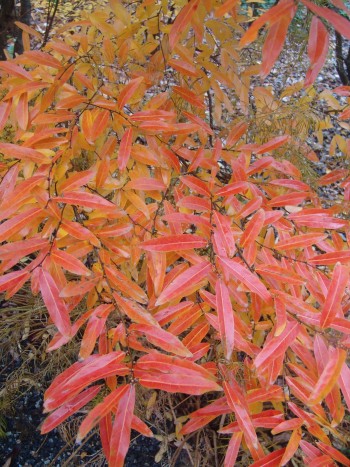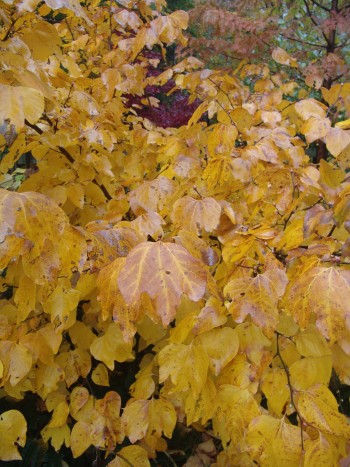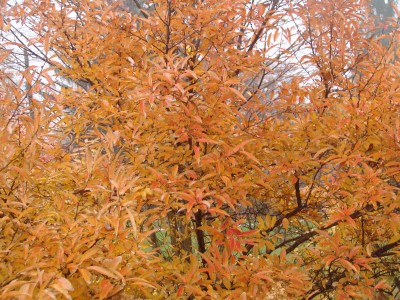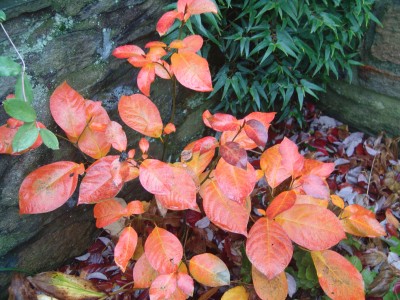Spicebushes at the Scott Arboretum
Throughout the Crum Woods that surrounds the campus is the native spicebush, Lindera benzoin. In very early spring the naked branches are covered with attractive, tiny, yellow flowers. Most spice bushes have chemicals in the stems and leaves which give them a spicy fragrance and make them unattractive to deer. In addition to the flowers, it is perhaps the fall color that makes the spicebushes most attractive.
Lindera obtusiloba, Oriental spicebush has incredible, vibrant golden-yellow fall color. At maturity this shrub can reach twelve feet tall with an equal spread. The leaves are similar in shape to those of our native sassafras, Sassafras albidum, in that there are three leaf types: entire, mitten-shaped, and three lobed. There is a wonderful multi-stemmed specimen growing in the Terry Shane Teaching Garden. It creates an umbrella-like effect over a bench in the garden.
Lindera glauca var. salicifolia, pale spicebush, is simply one of the very best shrubs for fall color in this area. The narrow leaves change from yellow to pumpkin orange and fade to beige and then tawny for most of the winter. Like Lindera obtusiloba it can get sizeable over time. We have used it in several locations on campus including the Scott Map Building and in Hicks Parking Lot where it was under-planted with Hakonechloa macra. Most recently it was added to our Gold Medal Garden around Kemp Hall. This spicebush received the Gold Medal in 2008 from the Pennsylvania Horticultural Society for its outstanding merit as a woody landscape plant.
The latest addition to our collection of Lindera is L. reflexa, a native to temperate parts of China. The bold leaves turn a beautiful orange fall color. There is a young specimen planted to the west side of Mertz Dormitory.
This relatively unknown genus has a host of extremely ornamental plants, especially in the fall. We have added others to our collections including Lindera erythrocarpa (Lang Music Building) and the evergreen, Lindera strychnifolia (being grown on in our nursery). We also plan to add other species for evaluation as they become available in nurseries.
Stop by the Scott Arboretum this fall to see which Lindera you might like to add to your garden.









Andrew Bunting
Posted at 14:19h, 19 NovemberI have had some inquiries regarding invasiveness. We have several fruiting specimens of Lindera glauca var. salicifolia and have never noticed a seedling. I have heard from others who grow Lindera obtusiloba that if you have multiple plants of male and female plants that seeding from them can be a problem. So, if you would like to grow L. obtusiloba I would suggest just growing an individual plant.
AB
EA
Posted at 13:00h, 09 SeptemberHi
Permission requested to use the lindera picture in an article about autumn foliage in a magazine for horticulture professionals (landscapers, architects, nursery…) with proper credit added.
The magazine is upon subscription only, published at 5000 copies 8 times a year, in french, in Quebec (Canada). The magazine doesn’t have a website, but a single page at http://www.quebecvert.com.
The picture would be 1,5 inch X 1,5 inch among 10 other colorful shrubs and trees featured in a 4 pages article.
We would need an answer before September 11th, 2009.
Best regards
Emmanuelle Ares, editor-in-chief
Chloe Pitard
Posted at 15:55h, 30 OctoberWhat would you suggest as the best way to propogate L. glauce var. salicifolia? I want several plants.
Andrew Bunting
Posted at 09:09h, 04 NovemberChloe,
Probably the best way to try to propagate many plants is from seed. Cold stratification of 3 months would be best. Therefore you could collect the seeds now. Sow them in a flat that is kept outdoors for the winter. Cover it to keep squirrels, etc. out of it, and then you should get reasonable germination in the spring. Also, cuttings taken in mid-June with a fairly strong hormone with mist should result in 50% rooting.
Andrew Bunting, Curator
Andrew Bunting
Posted at 09:12h, 04 NovemberTo follow-up on the potential invasiveness of this plant, I have spoken to a fellow horticulturist in Pennsylvania and then have noticed seedlings coming up under their L. salicifolia var. glauca after several years. If you could find all male plants this would be the best approach.
Andrew Bunting, Curator
April Clarke
Posted at 22:06h, 16 DecemberMr Bunting,
I am interested in propagating Lindera glauca salicifolia ,
your info is very helpful. I have not grown trees from seed before. I recently aquired this plant not sure of the age, pot grown 4′ now.
I do not see seeds on the plant, maybe next year after being in the ground a year ? Is it possible to get seeds from you? I have wanted to visit the Arboretum and could make the trip.
Thanks
April Clarke
Hatfield PA
Andrew Bunting
Posted at 14:15h, 20 DecemberApril,
We could either send you seed or you could collect it yourself. Email me at abuntin1@swarthmore.edu to make arrangements.
Andrew Bunting, Curator
stephen bulman
Posted at 11:42h, 11 NovemberDear Sir/Madame
Please can you advice me where I can obtain seeds of
lindera. I would to grow them in England.
Regards Stephen
Lisa Papile
Posted at 11:44h, 25 JulyWe have a client interested in the Lindera glauca var. salicifolia.
We do have a wholesale nursery and would be interested in purchasing a few liners from you.
Can you let me know if you have any material for sale.
Sincerely,
Lisa Papile
Ogden’s Design and Plantings
650 North Country Road
St. James, NY 11780
631-473-5064
Andrew Bunting
Posted at 10:30h, 29 JulyWe do not sell liners but can provide seed to nurseries or individuals in the U. S.
Andrew Bunting, Curator
Cherie
Posted at 09:27h, 17 MayI am from southeast Kansas zone 6 have been looking for and trying to purchase the Spicebush, Botanical Name: Lindera glauca var. salicifolia. If unable to buy would I be able to purchase some seeds. Thankyou so much, cherie
Paula
Posted at 07:20h, 06 AugustI grow it and have tons of seeds every year. I’d be glad to send you some. I’m in southeast PA, 30 miles west of Philly. Email me.
Becky Robert
Posted at 07:21h, 06 AugustThank you for sharing, Paula.
Sincerely,
Becky Robert
PR and Volunteer Programs Coordinator
thomas pollock
Posted at 10:40h, 22 MayGreetings. I am interested ,as well, in obtaining seed for Lindera glauca salicifolia..
Would like to try my hand at germination of any of the Lindera ssp. that you may have available.
I recently retired from the Highland Botanical Park in Rochester NY after 30+years. Served as a Horticulturist and Department Superintendent. Presently enjoy finding and trying new (to me) species of familiar and quite useful plant material.
https://www.linkedin.com/in/tom-pollock-7b537531/
I would be happy to send you any postal related fees and or make a donation which ever is most appropriate
Becky Robert
Posted at 09:13h, 30 JulyDear Thomas,
Thank you for your request. Reach out to our curator, Mary Tipping to learn more about our seed collecting procedures.
Sincerely,
Becky Robert
Scott Arboretum